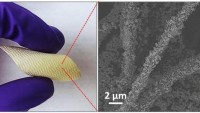New Technique Maps Damage to DNA Caused by Smoking
| Arthur Dominic Villasanta | | Jun 14, 2017 10:51 PM EDT |
(Photo : Christ-claude Mowandza-ndinga (UNC Health Care)) For the first time, scientists at the UNC School of Medicine. created a method for effectively mapping that DNA damage at high resolution across the genome.
Scientists at the University of North Carolina School of Medicine have become the first to develop a method for effectively mapping that damage caused to DNA by smoking at high resolution across the genome.
The new technique developed by a team of scientists led by Nobel Laureate Dr. Aziz Sancar MD, PhD reveals the genome-wide DNA damage a major carcinogen causes.
Like Us on Facebook
Dr. Sancar was awarded the Nobel Prize in Chemistry in 2015 along with Tomas Lindahl and Paul L. Modrich for their mechanistic studies of DNA repair.
In a study published in the Proceedings of the National Academy of Sciences, Dr. Sancar and his team developed a useful technique for mapping sites on the genome that are undergoing repair following a common type of DNA damage.
They then used that technique to map all damage caused by the major chemical carcinogen -- benzo[α]pyrene.
"This is a carcinogen that accounts for about 30 percent of the cancer deaths in the United States, and we now have a genome-wide map of the damage it causes," said Dr. Sancar.
Maps like these will help scientists better understand how smoking-induced cancers originate; why some people are more vulnerable or resistant to cancers and how these cancers might be prevented.
Dr. Sancar also hopes that providing such stark and specific evidence of smoking's harm at the cellular level might induce some smokers to kick the habit. There are about 40 million smokers in the United States and a billion worldwide.
"It would be good if this helps raise awareness of how harmful smoking can be," he said.
"It also would be helpful to drug developers if we knew exactly how DNA damage is repaired throughout the entire genome."
Benzo[α]pyrene (BaP) is a member of a family of simple, hardy, carbon-rich hydrocarbons -- polycyclic aromatic hydrocarbons -- that can form even in outer space.
Scientists think these molecules might have seeded simple carbon-based life on Earth and other planets. But for more evolved and complex DNA-based life forms such as humans, BaP poses a serious environmental hazard.
It's a byproduct of burning organic compounds such as tobacco plants. Everyday forms of combustion, from forest fires to diesel engines and barbecue grills, put a lot of BaP into our air, soil, and food. But nothing in ordinary life delivers it into human tissue more efficiently than puffing on a lit cigarette.
Typically, when a toxic hydrocarbon gets into a person through breathing or eating, enzymes in our blood break it down into smaller, safer molecules. That also happens for BaP, but the protective reactions also yield a compound called benzo[α]pyrene diol epoxide (BPDE), which turns out to be worse than BaP itself.
BPDE reacts chemically with DNA, forming a very tight bond at the nucleobase guanine. This bond, or adduct, means that the genes can no longer make proper proteins and DNA can't be duplicated properly during cell division. And if that happens, disease can be the result.
"If a BPDE adduct occurs in a tumor suppressor gene and isn't repaired in a timely manner, it can lead to a permanent mutation that turns a cell cancerous," said Wentao Li, PhD, a postdoctoral researcher and lead author of the study.
There is no doubt about the basic carcinogenicity of chemical reaction. Paint a moderate dose of BaP on the skin of a lab mouse, and tumors are almost certain to erupt.
BaP, via BPDE, has long been recognized as a promoter of multiple types of cancer and is considered the single most important cause of lung cancer.
Sancar's new method for mapping BaP-induced DNA damage enables scientists to identify the sites on the genome where cells are trying to repair the damage.
Known as nucleotide excision repair, it involves the recruitment of special proteins that perform DNA surgery. They snip out the affected strand of DNA.
If all goes well, DNA-synthesizing enzymes then reconstruct the missing section of DNA from another unaffected strand. This is possible because all cell-based life forms on Earth have two complementary strands of DNA. The snipped-out damaged section of DNA floats free until garbage-disposal molecules eventually degrade it.
TagsUniversity of North Carolina School of Medicine, DNA, Nobel Laureate Dr. Aziz Sancar, genome, benzo[α]pyrene, BaP, benzo[α]pyrene diol epoxide, BPDE
©2015 Chinatopix All rights reserved. Do not reproduce without permission
EDITOR'S PICKS
-

Did the Trump administration just announce plans for a trade war with ‘hostile’ China and Russia?
-

US Senate passes Taiwan travel bill slammed by China
-

As Yan Sihong’s family grieves, here are other Chinese students who went missing abroad. Some have never been found
-

Beijing blasts Western critics who ‘smear China’ with the term sharp power
-

China Envoy Seeks to Defuse Tensions With U.S. as a Trade War Brews
-

Singapore's Deputy PM Provides Bitcoin Vote of Confidence Amid China's Blanket Bans
-

China warns investors over risks in overseas virtual currency trading
-

Chinese government most trustworthy: survey
-

Kashima Antlers On Course For Back-To-Back Titles
MOST POPULAR
LATEST NEWS
Zhou Yongkang: China's Former Security Chief Sentenced to Life in Prison

China's former Chief of the Ministry of Public Security, Zhou Yongkang, has been given a life sentence after he was found guilty of abusing his office, bribery and deliberately ... Full Article
TRENDING STORY

China Pork Prices Expected to Stabilize As The Supplies Recover

Elephone P9000 Smartphone is now on Sale on Amazon India

There's a Big Chance Cliffhangers Won't Still Be Resolved When Grey's Anatomy Season 13 Returns

Supreme Court Ruled on Samsung vs Apple Dispute for Patent Infringement

Microsoft Surface Pro 5 Rumors and Release Date: What is the Latest?












